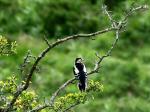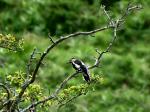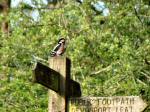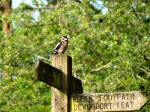Latin Name - Dendrocopos major
Larger and more common than the other British pied woodpecker, the Lesser
Spotted Woodpecker. It is blackbird-sized and black with a large white
shoulder patch and scarlet underneath the tail. The male has a red patch
on the back of the head which is absent in the female and juveniles have
a red crown, pink vent and "blotchy" white shoulder patches.
They eat insects, seeds and nuts but will also take bird eggs and nestlings
from nests during the breeding season. The woodpecker's tongue is extremely
long and sticky for extracting insects, such as ants, from their nest
chambers and crevices. It has a very distinctive bouncing flight as they
completely fold their wings against the body between each series of several
flaps. They spend most of their time clinging to tree trunks and branches
using their stiff tail feathers as a prop and its specialised toes with
two pointing forwards and two pointing backwards. Its presence is easily
detected by its loud alarm call. The male Great Spotted Woodpecker is
also renowned for drumming its bill on a branch, which usually last only
a few seconds and comprises 8-12 beats and fades away at the end. Usually
found in woodlands with mature broad-leaved trees, they can also be seen
in parks and gardens and will visit peanut feeders and bird tables. |









